A Look At This Year’s Spring Break For Pilots
by Steve Schapiro
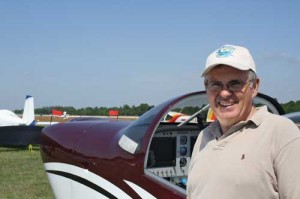
Mike Cooper has been flying for years – first in the Air Force where he instructed in T-38s before flying F-4s and F-15s, and then for Northwest Airlines where he was a captain flying DC-9s and A-320s, before retiring in 2006. But he had never been to Sun ‘n Fun.
On Labor Day last year, he flew his RV-8 for the first time after spending three years and 11 months building it. When a high school friend who lives in Tampa suggested he fly the plane to Sun ‘n Fun, March 27-April 1, 2012 from his home in Iowa, Mike figured why not – the weather’s usually good in Florida this time of year (certainly better than Iowa), and there are plenty of airplanes and vendors to check out at the fly-in.
“I’d heard about Sun ‘n Fun and I go to Oshkosh quite a bit,” Mike said. “I thought, you know, I would try out Sun ‘n Fun.”
Jennings Lewis also decided he would try out Sun ‘n Fun for the first time. But he hadn’t heard too much about it. In fact, before starting flight lessons in February 2012, he didn’t know much about aviation.
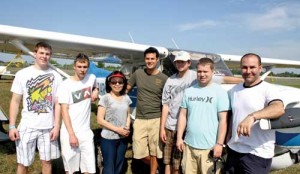
When he climbed into a Cessna 172 in Waterford, Michigan, with his instructor Chris Holton and fellow student Jim Peterson, Jennings had a total of 8 hours of flight time. He hadn’t even soloed yet. But that didn’t stop him from a flight-training trip in which he was one of five students, flying with two instructors in two airplanes from “Flight 101,” a flight school based at Pontiac Airport (KPTK).
The second plane, a Cessna 172RG, was flown by instrument students Jenny Shu and Dan Saliba, and Tyler Bertapelle, who is working on his private certificate with instructor, Kenneth Beason. The trip was Jenny’s second time to Sun ‘n Fun, and Dan’s fifth. The other five members of the Flight 101 group, including both instructors, were going for the first time.
One of the most encouraging things about the group is that five out of the seven are in their early 20s or younger.
“I’m more than twice as old as all of them,” Jenny joked. “I was telling one the young guys, ‘I bet you didn’t expect to go on your spring break with someone your mom’s age!’ We kind of laughed. The youngest one, Tyler, he’s still in high school. This is his senior year.”
Flying To Sun ‘n Fun
Although Mike and the Flight 101 group both started in the Midwest, their trips were quite different. Mike flew a less direct route and made overnight stops on his way to Florida and again on the trip back to Iowa, visiting family and friends.
The group from Michigan made the entire trip in one day, logging more than 10 hours of flight time both on the way to Florida and on the trip home. They planned legs of more than 250 nautical miles so Jenny and Dan could fulfill requirements for their IFR ratings and selected airports with lower fuel prices.
On the way to Florida the two planes made stops at Big Sandy Regional Airport (K22) in Prestonburg, Kentucky, where fuel was approximately $5.30 a gallon. After lunch, they were off to Greenville Spartanburg International Airport (KGSP) in Greer, South Carolina, where fuel was a bit higher – $6.19 a gallon. The final stop before coming into Lakeland was Cross City, Florida (KCTY). Fuel there was $5.29. Fuel at Sun ‘n Fun was $6.24 a gallon, which included a $0.20 discount.
The group had a full day of flying and arrived after dark, meaning the arrival procedure detailed in the NOTAM was no longer in effect. So Tyler, at the controls for the final leg, did get his first few hours of night flying, but didn’t get to fly over Burke Lake, rock the 172’s wings after a spotter on the ground radioed “red and white Cessna,” or land on a colored dot as instructed by the tower. Next time!
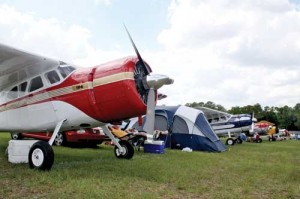
He also didn’t get his first night landing, as Kenneth handled that. Since the General Aviation camping was already closed for the night when the two aircraft arrived, they parked the planes at the FBO on the north side of the airport and set up their tents next to Dan’s parents, who winter in Lakeland with their RV and volunteer at Sun ‘n Fun. The next morning, the group moved the planes to Row 13 of the aircraft camping area just to the south of the departure end of Runway 9.
Mike took a somewhat scenic route, flying south from Fort Dodge, Iowa, to Stan Stumper Municipal Airport (KHHW) in Hugo, Oklahoma, en route to Brownsville, Texas (KBRO), where he spent the night and picked up his nephew Matt Cooper. The next day, the two followed the Gulf Coast over Corpus Cristi and Galveston before making a fuel stop in Hammond, Louisiana, to the east of Baton Rouge. From there, another three hours of flying and they arrived at Sun ‘n Fun and parked with several other RVs in the homebuilt area.
A Lot To See & Do

Pilots come to Sun ‘n Fun for a variety of reasons – the air show, to check out the newest avionics and other aviation products, and to see a whole variety of aircraft from the 275-pound WoW (Wonder of Wonders) Belite, which looks like a Wonder Bread bag with wings, to the Commemorative Air Force’s 75,000-pound B-29, “FiFi,” the only B-29 flying today in the world! Throw in plenty of Stearmans, T-6s, an Extra or two, a Harrier, and the Thunderbirds, and you’ve got it all.
“People go there for three purposes,” said Mike Cooper. “One, people want to look at and see what other people have done [building airplanes]. I know that’s what I go to air shows for…that’s my primary purpose. The other thing, I like to look at the vendors and see what’s out there – the new stuff – and then to see the air show itself. But the primary thing is to see other airplanes.”
Even though Dan Saliba has seen lots of different types of aircraft in the several years he has been going to Sun ‘n Fun, two stood out for him this year.
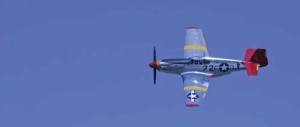
“I’ve never seen a Harrier before. Watching that thing fly in the air show and seeing it on the ground…that was amazing,” he said. “And also seeing the B-29 “FiFi” that was there. I’ve never seen a B-29 before. I’m really glad I got to see those.”
For most of the Flight 101 group, the air show was the highlight. Several of them were particularly impressed by Skip Stewart flying his modified Pitts S-2S, Prometheus, and John Mohr flying his Stock Stearman, performing the Masters of Mayhem routine featuring a knife-edge pass just off the deck, punctuated with explosions, a wall of fire, blaring music and Chris Darnell screaming down the runway in the Flash-Fire Jet Truck.
Each day featured different performers. Among the more impressive acts was Team RV, which touts itself as the world’s largest air show team with 12 pilots. Watching two flights of six aircraft wing-tip to wing-tip perform an opposing pass is something quite special to see.
Another uncommon act was Jim Peitz doing loops, rolls and very low, high-speed passes in his Bonanza F33C. There’s just something fun about seeing aerobatics performed in certified production aircraft.
And of course, the United States Air Force Thunderbirds dazzled the crowd with precision maneuvers in their F-16s.
Light Up The Night
Typically, once 5 pm rolls around, the vendors roll up shop, and the grounds empty out. But on Friday night, visitors were treated to something special after dark – a night air show. “It’s just a totally different experience. I don’t know how to describe it,” Jenny Shu said. “Being at nighttime adds a mysterious feeling.”
“The formation flying at night I thought was real impressive,” Kenneth Beason said, referring to the Aeroshell Team. “They do all this stuff that they do during the day, but now they’re adding that additional element of night.”
After seeing “Otto,” a Schweizer 300C helicopter, perform a 12-minute show filled with pyrotechnics, Kenneth was left asking himself, “How do you get approval to launch fireworks off your airplane?”
While the students were most interested in the air show performers, Kenneth spent some time checking out the vendors. He wasn’t alone, however, as Jennings Lewis and Jenny Shu both purchased headsets.
The product that garnered the most attention by far was the Stratus receiver, developed in partnership with ForeFlight and Appareo. It provides in-flight weather and ADS-B for iPad users with the ForeFlight app through a Bluetooth connection. The portable receiver provides NEXRAD radar, METARS, TAFs, winds aloft, TFRs and GPS position to anyone with a ForeFlight subscription. Essentially what it does is provide the same weather information a ForeFlight user has on the ground through a WIFI connection, but in the air. The receiver costs $799 and there are no monthly subscription fees, although you do need ForeFlight to use it, which has a $75 annual fee, which is still less expensive than paper chart subscriptions, less cumbersome, and offers so much more utility!
“The box is exciting because instead of landing or not knowing [what the weather is], you’ll be able to make a decision in the air, instead of having to land and look at a computer screen,” Kenneth Beason said. “I’m trying to figure out how to buy one.”
Who says that the cost of flying is increasing? ForeFlight and Appareo are helping to reduce the cost of flying, while increasing aircraft utility, pilot education and safety.
Appareo is a Midwest company, headquartered in Fargo, North Dakota.

Among the aircraft displays that were getting a lot of attention were a couple of experimental designs. Velocity debuted its V-Twin, a twin-engine version of the sleek, four-place canard design. The prototype made its first flight just two weeks before the start of Sun ‘n Fun, and uses the same fuselage as a traditional Velocity, but it replaces the winglets, which serve as rudders, with a conventional vertical stabilizer and rudder.
Another aircraft that was in the running for the “Dead Grass Award” (despite being parked on pavement) was the 9/10-scale Spitfire available from Supermarine Spitfire of Texas. The all-aluminum, two-seat replica making its first appearance at Sun ‘n Fun sells for $168,000 for the airframe kit with the engine priced at another $46,000.
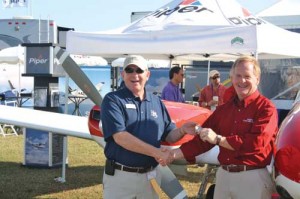
Of course, there were big displays by Piper, celebrating the 75th Anniversary of the Piper Cub; Cessna, and Hawker Beechcraft. On Thursday, about 50 aircraft flew over to Fantasy of Flight for the annual Splash-In on Lake Agnes. Visitors could see everything from a Trike on floats to Kermit Weeks’ four-engine Short Sunderland (although it stayed in the hangar). Other exotic aircraft that were on display were Fantasy of Flight’s Grumman Duck and the Sikorsky S-39 with its distinctive leopard pattern paint scheme, which Kermit flew at the Splash-In.
Bouncing Back
With a struggling economy and last year’s tornado that ripped through the Sun ‘n Fun grounds, the question on everyone’s mind was how was attendance?
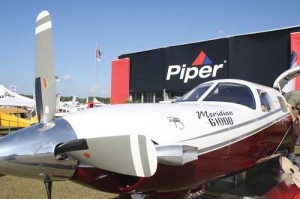
The weather was seasonably warm and sunny every day (with the exception of a short rain shower on Saturday), which certainly contributed to what organizers said was record attendance. A strong weekend crowd must have made up for what seemed to be a light crowd early in the week. On Monday night, there were only 40 planes in General Aviation Camping and the lines at lunchtime on Tuesday and Wednesday were quite short (which was a nice surprise).
One issue several people commented on was having to leave the homebuilt parking area at 12:30 pm for the start of the air show for safety reasons. What made things worse, volunteers blowing whistles were none-too-polite in clearing the area as early as 12:10 pm. Some even refused to allow newly arrived pilots to tie down, which is surprising given how quickly the storm hit last year.
“I really didn’t like the fact that you couldn’t be around the airplanes, the homebuilt area anyhow, during the show,” Mike Cooper said. “The primary thing is to see other airplanes, and during the show you can’t do that. That really detracts [from the event].”
However, Mike heard that might be changing. This was the first Sun ‘n Fun under the leadership of John “Lites” Leenhouts, and overall things seemed to run well. But whenever a new leader takes over, changes typically follow, and Mike heard rumors that homebuilt parking might be moved so visitors could see the aircraft on display during the show without compromising safety. Such a change would certainly be welcomed.
Time To Go Home
The Flight 101 group spent two full days in Lakeland before firing up their two 172s for an early morning departure on Sunday. Once again they planned a fairly direct route. However, weather was a problem heading back up to Michigan, which required some changes, and a reminder of how nice it would be to have the Stratus receiver with real-time weather in the cockpit. Next year!
“On the return flight we had to dodge some thunderstorms,” Kenneth said. “ATC is going through the list of planes they are talking to asking if they have onboard weather. Probably 90 percent of them said yes, and then they get to us and we say, ‘No, we definitely would appreciate vectors around any storms you may see.’” The group witnessed firsthand how beneficial ADS-B will be to both pilots and air traffic control once the GA fleet is fully equipped.
The experience proved a great training exercise as the student pilots got to fly in actual IMC conditions and had to make decisions on using alternate airports, when to launch and when to wait, adding another aspect of fun to the trip. “The journey itself is exciting for me,” Jenny said. “Getting there and coming back, the trip itself is very exciting.”
Mike didn’t have to fly around any storms as he took his time heading back to Iowa, stopping off to visit friends. After two days of looking at airplanes, checking out vendors and watching the air show, he flew over to Tampa Executive and spent some time on the beach. The next day he flew to Tullahoma, Tennessee, where he spent the day visiting an Air Force buddy and touring the Jack Daniels distillery. That left him with only a few hours of flying to get home.
Before leaving Sun ‘n Fun, Mike did pick up one thing – a plaque for “Outstanding Homebuilt.” There were two or three others that placed higher than his RV-8, but the recognition was a nice surprise.
“I wasn’t sure I was going to enter it into any kind of judging,” Mike said. “I wasn’t really prepared.” Just as he casually decided to check out Sun ‘n Fun, he figured it couldn’t hurt to allow the judges to look over his plane. Now his award is serving as a bit of inspiration. “I’m going to make a few changes, fly into Oshkosh, and see how it does up there.”
EDITOR’S NOTE: Steve Schapiro is a private pilot and aircraft owner, and was senior editor of EAA Sport Aviation from 2010-11. He has lived in Chicago, Illinois and Oshkosh, Wisconsin. He is currently on special assignment with the Commemorative Air Force as a freelance journalist. Schapiro flew his 1968 Piper Arrow from Warren, New Jersey to Lakeland, Florida for Sun ‘n Fun. His father, Jack Elliott, is a noted aviation author (i.e. Adventures In Flying).